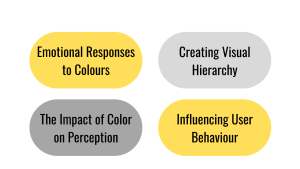content
UI/UX design
January 9, 2024
6 min read
Introduction
In the dynamic realm of user interface (UI) and user experience (UX) design, every element plays a crucial role in shaping the overall interaction between users and digital products. One often underestimated yet incredibly powerful element is colour. The impact of colours on human psychology has been extensively studied and documented, and savvy designers are increasingly recognising the potential of colour psychology in shaping user emotions, perceptions, and actions.
Understanding Colour Psychology
Colour psychology explores how different colours can evoke specific emotions, trigger certain behaviours, and influence perceptions. Designers leverage this knowledge to create visually appealing and user-friendly interfaces that resonate with their target audience. Let’s delve into some key aspects of colour psychology in UI/UX design.

Emotional Responses to Colours
Colours have the remarkable ability to evoke emotions and set the tone for user experiences. For instance, warm colours like reds and yellows tend to create a sense of energy, passion, and urgency, while cool colours like blues and greens evoke calmness, trust, and serenity. By strategically selecting colour palettes, designers can craft interfaces that align with the intended emotional response.
The Impact of Color on Perception
Color plays a pivotal role in shaping how users perceive a brand or product. Certain colours are associated with specific qualities or characteristics. For instance, blue is often associated with trustworthiness and professionalism, making it a popular choice for corporate websites. Designers can utilise this association to enhance the perceived value of a product or service.
Creating Visual Hierarchy
In UI/UX design, visual hierarchy is crucial for guiding users through a seamless and intuitive experience. Colours can be employed to create a hierarchy by emphasising certain elements over others. Bold and contrasting colours can draw attention to important buttons or calls to action, guiding users to take desired actions.
Influencing User Behaviour
Colours can significantly impact user behaviour and decision-making. The psychology of colour suggests that red can create a sense of urgency and encourage immediate action, making it an effective choice for “Buy Now” buttons or alerts. On the other hand, softer tones may promote a sense of relaxation and exploration, encouraging users to browse content or engage with the interface.
Strategies for Effective Colour Usage

Understand Your Audience
The first step in incorporating colour psychology into UI/UX design is understanding the target audience. Different demographics and cultures may have varying associations with colours. Conducting research and user testing can provide valuable insights into the preferences and responses of the intended users.
Consistency Across Platforms
Maintaining a consistent colour scheme across various platforms and devices is crucial for brand recognition and a cohesive user experience. Consistency fosters a sense of familiarity, making it easier for users to navigate and engage with the interface.
Accessibility Considerations
While selecting colours, designers must also consider accessibility for users with visual impairments. Ensuring sufficient contrast between text and background colours, providing alternative text for images, and choosing accessible colour combinations are essential steps in creating an inclusive design.
Conclusion
In the ever-evolving landscape of UI/UX design, colour psychology stands out as a powerful tool for creating impactful and memorable user experiences. By understanding the emotional, perceptual, and behavioural aspects of colours, designers can craft interfaces that not only captivate users visually but also drive desired actions and establish strong connections between users and digital products. As technology continues to advance, the role of colour in design will undoubtedly become even more significant, shaping the way we interact with and perceive the digital world.
If you have any questions or an idea for a project, contact us via sales@instandart.com or fill out the form on the main page of the site to discuss.
